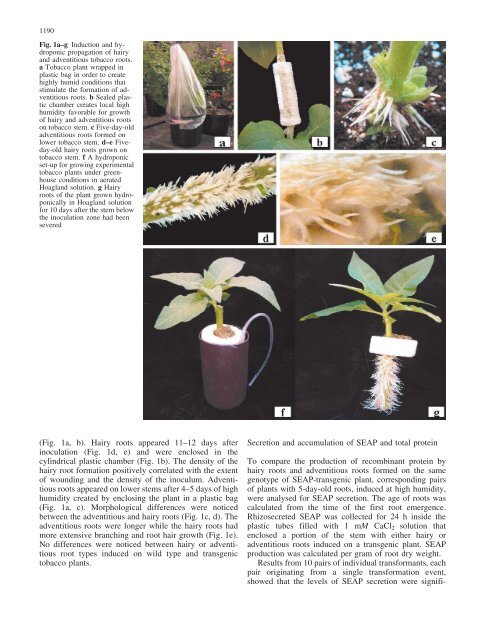Rhizosecretion of recombinant proteins from plant hairy ... - Springer
Rhizosecretion of recombinant proteins from plant hairy ... - Springer
Rhizosecretion of recombinant proteins from plant hairy ... - Springer
Create successful ePaper yourself
Turn your PDF publications into a flip-book with our unique Google optimized e-Paper software.
1190<br />
Fig. 1a–g Induction and hydroponic<br />
propagation <strong>of</strong> <strong>hairy</strong><br />
and adventitious tobacco roots.<br />
a Tobacco <strong>plant</strong> wrapped in<br />
plastic bag in order to create<br />
highly humid conditions that<br />
stimulate the formation <strong>of</strong> adventitious<br />
roots. b Sealed plastic<br />
chamber creates local high<br />
humidity favorable for growth<br />
<strong>of</strong> <strong>hairy</strong> and adventitious roots<br />
on tobacco stem. c Five-day-old<br />
adventitious roots formed on<br />
lower tobacco stem. d–e Fiveday-old<br />
<strong>hairy</strong> roots grown on<br />
tobacco stem. f A hydroponic<br />
set-up for growing experimental<br />
tobacco <strong>plant</strong>s under greenhouse<br />
conditions in aerated<br />
Hoagland solution. g Hairy<br />
roots <strong>of</strong> the <strong>plant</strong> grown hydroponically<br />
in Hoagland solution<br />
for 10 days after the stem below<br />
the inoculation zone had been<br />
severed<br />
(Fig. 1a, b). Hairy roots appeared 11–12 days after<br />
inoculation (Fig. 1d, e) and were enclosed in the<br />
cylindrical plastic chamber (Fig. 1b). The density <strong>of</strong> the<br />
<strong>hairy</strong> root formation positively correlated with the extent<br />
<strong>of</strong> wounding and the density <strong>of</strong> the inoculum. Adventitious<br />
roots appeared on lower stems after 4–5 days <strong>of</strong> high<br />
humidity created by enclosing the <strong>plant</strong> in a plastic bag<br />
(Fig. 1a, c). Morphological differences were noticed<br />
between the adventitious and <strong>hairy</strong> roots (Fig. 1c, d). The<br />
adventitious roots were longer while the <strong>hairy</strong> roots had<br />
more extensive branching and root hair growth (Fig. 1e).<br />
No differences were noticed between <strong>hairy</strong> or adventitious<br />
root types induced on wild type and transgenic<br />
tobacco <strong>plant</strong>s.<br />
Secretion and accumulation <strong>of</strong> SEAP and total protein<br />
To compare the production <strong>of</strong> <strong>recombinant</strong> protein by<br />
<strong>hairy</strong> roots and adventitious roots formed on the same<br />
genotype <strong>of</strong> SEAP-transgenic <strong>plant</strong>, corresponding pairs<br />
<strong>of</strong> <strong>plant</strong>s with 5-day-old roots, induced at high humidity,<br />
were analysed for SEAP secretion. The age <strong>of</strong> roots was<br />
calculated <strong>from</strong> the time <strong>of</strong> the first root emergence.<br />
Rhizosecreted SEAP was collected for 24 h inside the<br />
plastic tubes filled with 1 mM CaCl 2 solution that<br />
enclosed a portion <strong>of</strong> the stem with either <strong>hairy</strong> or<br />
adventitious roots induced on a transgenic <strong>plant</strong>. SEAP<br />
production was calculated per gram <strong>of</strong> root dry weight.<br />
Results <strong>from</strong> 10 pairs <strong>of</strong> individual transformants, each<br />
pair originating <strong>from</strong> a single transformation event,<br />
showed that the levels <strong>of</strong> SEAP secretion were signifi-



